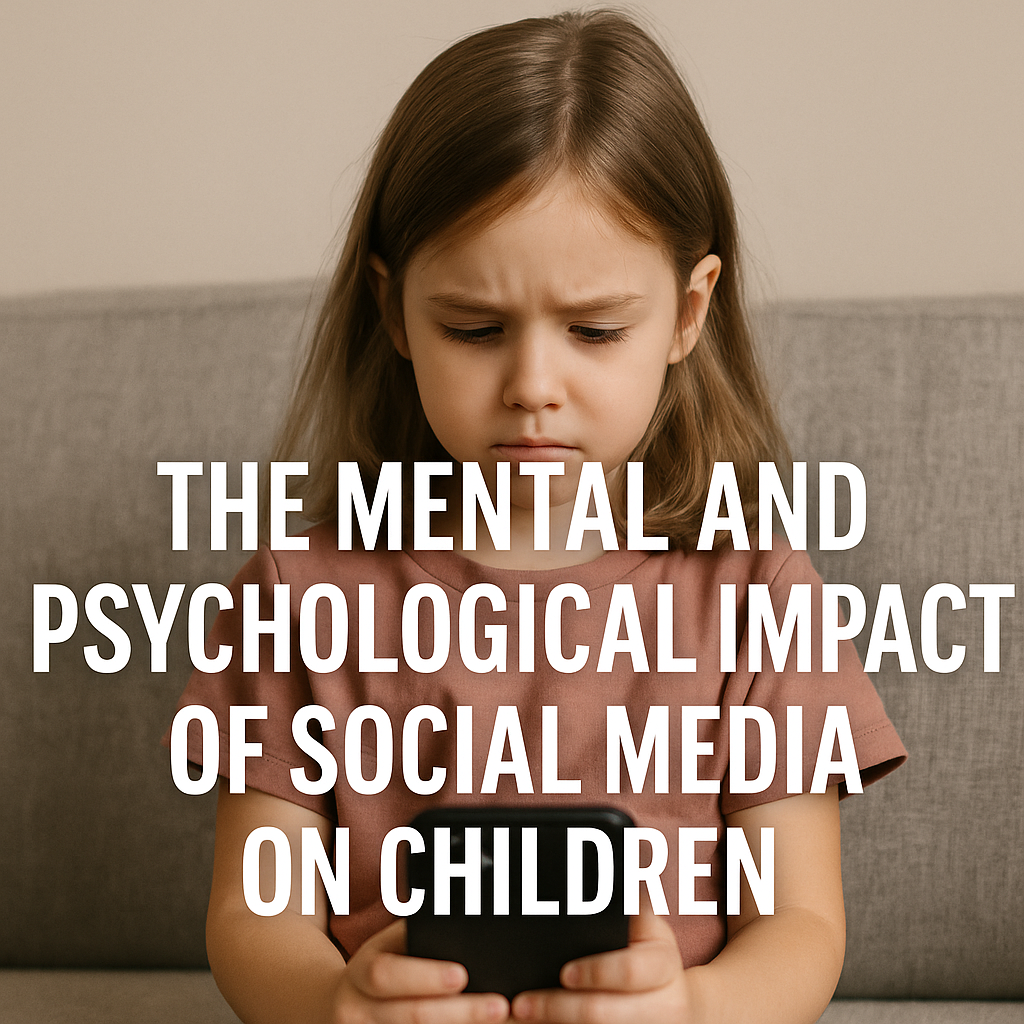Understanding the Digital Shift in Childhood
In today’s world, children as young as five are becoming increasingly exposed to social media platforms—either directly through kid-targeted apps or indirectly via family devices. While many parents see platforms like YouTube Kids, TikTok, and Instagram Reels as harmless distractions, the reality is far more complex. The mental and psychological impact of social media on children aged 5–8 is emerging as a serious concern among educators, psychologists, and public health experts.
At this developmental stage, children’s brains are highly neuroplastic—meaning they absorb behaviors, patterns, and emotions rapidly. Prolonged and unmonitored digital interaction during this period can shape their perception of self, relationships, and the world in ways that are deeply impactful and, in some cases, harmful.
How Early Social Media Exposure Affects Brain Development
Children between the ages of 5 and 8 are in the preoperational cognitive stage, according to Jean Piaget’s theory. This means they rely heavily on visual cues, emotional feedback, and imitation to learn. Social media content—often highly emotional, edited, or filtered—feeds this dependency and can rewire the way they evaluate self-worth, emotions, and decision-making.
Several recent studies have shown that dopamine-driven feedback loops in apps can impact children’s reward centers in the brain. This creates compulsive behavior patterns like checking for likes, scrolling endlessly, or mimicking influencers—even when they do not fully understand the content.
Platforms engineered for adult attention spans and behaviors can create overstimulation, impatience, and difficulty focusing in young users. According to Harvard researchers, constant engagement with social media may elevate cortisol levels, increase screen-time addiction, and contribute to emotional dysregulation in children.
The Rise of Social Comparison and Low Self-Esteem
Children in this age group are just beginning to develop their sense of self. When they consume curated content featuring perfect families, extravagant toys, or flawless appearances, they begin to compare their own lives and belongings—often negatively.
This fosters:
- Early signs of body image anxiety
- Low self-esteem from comparison-based content
- Desire for materialism due to toy unboxing and influencer marketing
- Performance anxiety from challenges, trends, or public feedback
A study by Common Sense Media showed that children under 8 who consumed influencer content frequently expressed more concern about their appearance, popularity, and possessions.
Emotional Dysregulation and Behavioral Issues
One of the more immediate effects of social media exposure in younger children is emotional instability. Sudden emotional shifts, tantrums, or shutdowns are often tied to the overstimulation found in digital content. This happens because children are unable to process the fast-paced narrative shifts, emotional exaggerations, and visual effects typical of platforms like YouTube Shorts or TikTok.
Key symptoms include:
- Increased irritability after screen time
- Tantrums when social media access is denied
- Trouble sleeping due to blue light and overstimulation
- Heightened aggression or withdrawal during real-life interactions
Psychology Today warns that children in this age range may become emotionally dependent on digital content to regulate their moods, leading to long-term challenges with frustration tolerance and patience.
Attention Span and Academic Impact
Children 5–8 are just beginning structured learning environments. Their ability to focus, retain information, and follow instructions is fragile. Repeated exposure to rapid-cut videos, gamified notifications, and instant feedback systems trains the brain to expect constant novelty, leading to:
- Shortened attention spans
- Difficulty concentrating in class
- Boredom during non-stimulating activities
- Increased reliance on multitasking behavior
The American Academy of Pediatrics has recommended that screen time be strictly limited for children under 8, highlighting how unmoderated use can directly interfere with cognitive development and academic preparedness.
Parental Oversight and Algorithm Blindness
Most parents are unaware of how algorithmic personalization works. Even on platforms advertised as safe for children, such as YouTube Kids, the algorithm may begin to serve inappropriate, violent, or manipulative content simply based on viewing patterns.
A 2023 Stanford University report exposed how children’s viewing history often leads to increasingly extreme content, including fake challenges, misinformation, and disturbing videos disguised as cartoons.
Without parental oversight and critical media literacy, children are essentially left in the hands of systems optimized for engagement—not wellbeing.
The Risk of Early Anxiety and Depression
Early exposure to social media has been linked to symptoms of anxiety and depression in children. Triggers include:
- Social exclusion (not being tagged, mentioned, or noticed online)
- Fear of missing out (FOMO)
- Sensory overload
- Content promoting fear, dystopia, or unrealistic standards
While most 5–8-year-olds don’t have personal social accounts, passive consumption of this content via parents’ devices or shared screens still creates subconscious pressure and fear responses. The Child Mind Institute has documented increased cases of childhood anxiety linked to digital habits.
Digital Dependence and Withdrawal Symptoms
If access to social media is suddenly removed, children may experience:
- Mood swings
- Restlessness
- Difficulty sleeping
- Complaints of boredom or sadness
- Increased demand for digital stimulation
These are clear markers of early digital dependence—a form of behavioral addiction that mirrors traits found in substance withdrawal. Intervening early is critical to prevent long-term consequences.
What Can Be Done? Practical Recommendations for Parents and Schools
1. Delay Personal Device Ownership
Avoid giving children their own smartphones or tablets until absolutely necessary. Shared family devices should have parental controls and screen time limits.
2. Co-watch and Co-use Media
Watch what your child is consuming and ask reflective questions like:
- “What did you learn?”
- “Is that how things really are?”
- “Do you think this is real or made up?”
This builds media literacy and emotional awareness.
3. Promote Analog Activities
Balance screen time with real-world play, face-to-face interaction, and creative exploration. Encourage hobbies that activate their body and imagination.
4. Use Trusted Apps
If digital media is necessary, stick with vetted apps like:
5. Teach Digital Boundaries Early
Set clear expectations:
- No screens during meals or before bedtime
- No watching alone behind closed doors
- Scheduled media use windows
6. Stay Informed
Resources like Common Sense Media, MediaSmarts, and The News Literacy Project help parents stay up to date on emerging threats and digital parenting tips.
Conclusion: Guarding Mental Health in the Digital Age
Social media is not inherently evil—but its design priorities do not align with the developmental needs of children aged 5–8. Left unchecked, it can contribute to anxiety, emotional instability, self-esteem issues, and cognitive strain during the most formative years of brain development.
We must prioritize intentional parenting, school awareness, and strong digital literacy frameworks to ensure that children do not fall victim to systems they are not equipped to navigate. A well-informed approach can help them grow into emotionally healthy, confident, and critical digital citizens.
FAQs
How much screen time is healthy for kids aged 5–8?
Experts recommend no more than 1 hour per day of high-quality, co-watched screen time.
What are the signs of digital overexposure in children?
Mood swings, withdrawal, shorter attention spans, anxiety, and sleep problems are common signs.
Can social media ever be educational for young kids?
Yes—but only when used sparingly, with adult supervision, and via age-appropriate platforms.
What platforms are safest for kids under 8?
Apps like PBS Kids, Khan Academy Kids, and Sago Mini offer educational content without harmful ads or algorithms.


